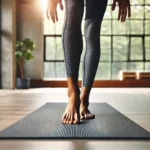Yoga is an ancient practice that dates back over 5,000 years to Northern India. Originally, yoga was a spiritual and meditative practice aimed at achieving harmony between the mind, body, and spirit. Over time, it has evolved to focus on physical postures (asanas) that help improve flexibility, strength, and mental clarity.
Today, yoga is recognized worldwide for its profound impact on the body and mind. Whether you’re looking to relieve back pain, help with digestion, or manage stress, yoga offers numerous benefits. In this post, we will dive into the top 12 yoga poses that are great for beginners, discuss how long to hold each pose, and answer frequently asked questions to guide you through your practice.
How Many Yoga Poses Are There?
In total, there are 84 classical yoga poses (asanas) according to ancient texts. However, modern yoga has hundreds of variations. Don’t worry, though—you don’t need to master them all to start your yoga journey. We’re going to focus on the top 12 essential poses that will give you a strong foundation.
History of Yoga and Its Benefits for the Body
Yoga’s origins can be traced back to ancient India, where it was part of a broader spiritual practice. The word “yoga” means “union,” referring to the connection between the mind, body, and spirit. Traditionally, yoga was used as a tool for self-awareness and inner peace. Today, while the spiritual aspects remain for some practitioners, the physical benefits are widely recognized.
Benefits for the body include:
- Increased flexibility and strength: Yoga stretches your muscles, improving both flexibility and strength, especially in the core, back, and legs.
- Relief from back pain and gas: Poses like Downward Facing Dog and Child’s Pose help relieve tension in the back, while twists and forward bends can aid digestion and alleviate constipation.
- Stress relief and mental clarity: Focusing on deep, mindful breathing helps manage stress and brings clarity to the mind.
The Top 12 Yoga Poses for Beginners
These foundational poses are designed to help you build flexibility, strength, and balance. They are suitable for all levels, including during pregnancy, and address common issues like back pain and difficulty with digestion.
- Mountain Pose (Tadasana)
- Description: The foundation of all standing poses, teaching proper alignment and posture.
- How to do it: Stand tall with feet together, arms by your sides, spine long, and weight evenly distributed on both feet.

- Downward Facing Dog (Adho Mukha Svanasana)
- Description: A full-body stretch that strengthens arms, legs, and back while relieving gas and back pain.
- How to do it: Form an inverted “V” with your body, hands pressed into the mat, hips lifted high, and heels reaching toward the ground.
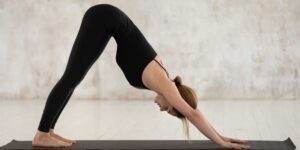
- Warrior I (Virabhadrasana I)
- Description: Builds leg strength and improves focus, helping with balance and stability.
- How to do it: Step one foot forward with the knee bent at 90 degrees, the back leg straight, and arms raised overhead.

- Warrior II (Virabhadrasana II)
- Description: Opens hips and chest, improving lower body flexibility.
- How to do it: Similar to Warrior I, but rotate your hips and shoulders to face the side, with arms extended parallel to the floor.
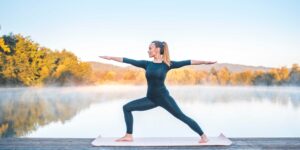
- Child’s Pose (Balasana)
- Description: A restful pose that gently stretches the lower back and aids digestion.
- How to do it: Kneel down, lower your hips to your heels, and extend your arms forward, resting your forehead on the mat.

- Cobra Pose (Bhujangasana)
- Description: A gentle backbend that stretches the spine and strengthens back muscles.
- How to do it: Lie on your stomach, press your hands under your shoulders, and lift your chest while keeping your pelvis grounded.
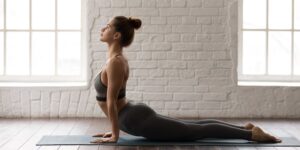
- Bridge Pose (Setu Bandhasana)
- Description: Stretches the chest, neck, and spine while strengthening the glutes and back.
- How to do it: Lie on your back, bend your knees, and lift your hips towards the sky, keeping your feet and arms grounded.
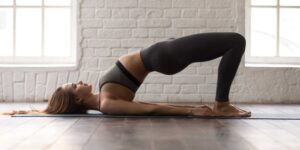
- Tree Pose (Vrksasana)
- Description: A balancing pose that builds stability and focus.
- How to do it: Stand on one leg, with the other foot placed on the inner thigh or calf, and raise your arms overhead or in prayer.

- Plank Pose
- Description: Strengthens the core, arms, and legs, preparing for more advanced poses.
- How to do it: Hold a push-up position with your body in a straight line from head to heels, engaging your core.
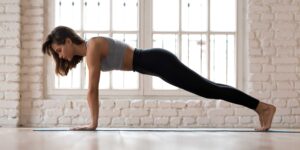
- Cat-Cow Stretch (Chakravakasana)
- Description: Warms up the spine and relieves lower back tension.
- How to do it: Alternate between arching your back (Cow) and rounding your spine (Cat) on hands and knees.
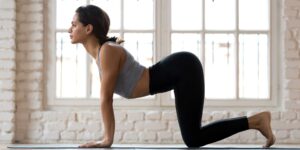
- Seated Forward Bend (Paschimottanasana)
- Description: Stretches the hamstrings and back, relieving lower back pain.
- How to do it: Sit with legs extended forward, hinge at your hips, and reach toward your feet while keeping your back long.

- Corpse Pose (Savasana)
- Description: A final resting pose to relax the body and mind.
- How to do it: Lie flat on your back, arms by your sides, and allow your body to relax fully.

Frequently Asked Questions About Yoga
How long do you hold a yoga pose?
In general, beginners should hold poses for 20-30 seconds, focusing on deep breathing. As you advance, you can hold more difficult poses, like Warrior or Crow Pose, for longer to build endurance.
How many reps in yoga?
Yoga doesn’t work in traditional “reps” like weightlifting. Instead, you typically flow between poses in a sequence. However, for static poses, holding for a count of 3-5 breaths is a good starting point.
What are yoga poses called?
Yoga poses are traditionally named in Sanskrit, the ancient language of India. For example, Downward Facing Dog is known as Adho Mukha Svanasana, and Warrior II is called Virabhadrasana II.
Things to Avoid in Yoga
- Don’t push through pain—if a pose feels too difficult, modify it or take a rest.
- Avoid locking your joints, especially in poses like Plank or Warrior. Keep a soft bend in your knees and elbows to prevent strain.
- Don’t rush your practice; yoga is about mindfulness, not speed.
Yoga for Special Needs: Pregnancy and Digestive Health
Yoga is safe and beneficial for most people, including those who are pregnant. Poses like Cat-Cow Stretch and Bridge Pose are particularly helpful during pregnancy as they relieve tension in the back and pelvis.
If you’re struggling with digestion issues like gas or constipation, poses like Child’s Pose, Seated Forward Bend, and gentle twists can help alleviate discomfort.


